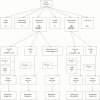Fetal or infant death in twin pregnancy: neurodevelopmental consequence for the survivor
- PMID: 11815541
- PMCID: PMC1721371
- DOI: 10.1136/fn.86.1.f9
Fetal or infant death in twin pregnancy: neurodevelopmental consequence for the survivor
Abstract
Aim: To determine the neurodevelopmental morbidity in the surviving twin after fetal or infant death of the co-twin.
Methods: Twin pregnancies with an antepartum or infant death delivered between 1981 and 1992 were identified from the Northern Perinatal Mortality Survey. Information on the neurodevelopmental morbidity of infant survivors of a deceased co-twin was obtained by a questionnaire sent to the community paediatrician or general practitioner.
Results: A total of 111 children who survived infancy after the fetal death of the co-twin (group 1) and 142 from liveborn twin pairs in which one twin died in infancy (group 2) were traced. Responses were received from 97 (87%) and 130 (92%) respectively. In group 1, the cerebral palsy prevalence was 93 (95% confidence interval (CI) 43 to 169) per 1000 infant survivors; it was more common in like-sex pairs (8/70) with a prevalence of 114 (95% CI 51 to 213) compared with 45 (95% CI 1 to 228) per 1000 infant survivors in unlike-sex pairs (1/22). The overall prevalence of neurodevelopmental morbidity (including developmental delay) was 175 (95% CI 106 to 266) per 1000. In group 2, the cerebral palsy prevalence was 154 (95% CI 84 to 223) per 1000 infant survivors in like-sex (16/104) and 77 (95% CI 9 to 251) in unlike-sex (2/26) survivors; the overall prevalence of neurodevelopmental morbidity was 246 (95% CI 172 to 320) per 1000.
Conclusions: The risk of cerebral palsy is increased in the surviving twin after a fetal or infant co-twin death compared with the general twin population. Like-sex twins are at greater risk than unlike-sex. The probable cause, in addition to the consequences of prematurity, is twin-twin transfusion problems associated with monochorionicity.
Figures
Similar articles
-
Cerebral palsy in the surviving twin associated with infant death of the co-twin.Arch Dis Child Fetal Neonatal Ed. 2001 Mar;84(2):F111-6. doi: 10.1136/fn.84.2.f111. Arch Dis Child Fetal Neonatal Ed. 2001. PMID: 11207227 Free PMC article.
-
Consequences of in-utero death in a twin pregnancy.Lancet. 2000 May 6;355(9215):1597-602. doi: 10.1016/s0140-6736(00)02215-7. Lancet. 2000. PMID: 10821363
-
Long-term neurodevelopmental outcome in twin-to-twin transfusion syndrome.Am J Obstet Gynecol. 2003 Nov;189(5):1314-9. doi: 10.1067/s0002-9378(03)00760-9. Am J Obstet Gynecol. 2003. PMID: 14634561
-
Risk for surviving twin after fetal death of co-twin in twin-twin transfusion syndrome.Obstet Gynecol. 1998 Aug;92(2):215-9. doi: 10.1016/s0029-7844(98)00159-8. Obstet Gynecol. 1998. PMID: 9699754 Review.
-
Long-Term Neurodevelopmental Outcome in Survivors of Twin-to-Twin Transfusion Syndrome.Twin Res Hum Genet. 2016 Jun;19(3):255-61. doi: 10.1017/thg.2016.26. Epub 2016 May 3. Twin Res Hum Genet. 2016. PMID: 27137794 Review.
Cited by
-
Neuropsychological screening of a group of preterm twins: comparison with singletons.Childs Nerv Syst. 2008 Feb;24(2):225-30. doi: 10.1007/s00381-007-0422-6. Epub 2007 Aug 21. Childs Nerv Syst. 2008. PMID: 17710418
-
Cerebral palsy in twins: a national study.Arch Dis Child Fetal Neonatal Ed. 2002 Sep;87(2):F122-4. doi: 10.1136/fn.87.2.f122. Arch Dis Child Fetal Neonatal Ed. 2002. PMID: 12193519 Free PMC article.
-
Cerebral palsy in triplet pregnancies with and without iatrogenic reduction.Eur J Pediatr. 2004 Aug;163(8):449-51. doi: 10.1007/s00431-004-1462-5. Epub 2004 Jun 8. Eur J Pediatr. 2004. PMID: 15185147
-
Birth Outcomes by Infertility Treatment: Analyses of the Population-Based Cohort: Massachusetts Outcomes Study of Assisted Reproductive Technologies (MOSART).J Reprod Med. 2016 Mar-Apr;61(3-4):114-27. J Reprod Med. 2016. PMID: 27172633 Free PMC article.
-
Adverse pregnancy outcomes after in vitro fertilization: effect of number of embryos transferred and plurality at conception.Fertil Steril. 2015 Jul;104(1):79-86. doi: 10.1016/j.fertnstert.2015.04.006. Epub 2015 May 5. Fertil Steril. 2015. PMID: 25956368 Free PMC article. Clinical Trial.
References
Publication types
MeSH terms
LinkOut - more resources
Full Text Sources
Medical

